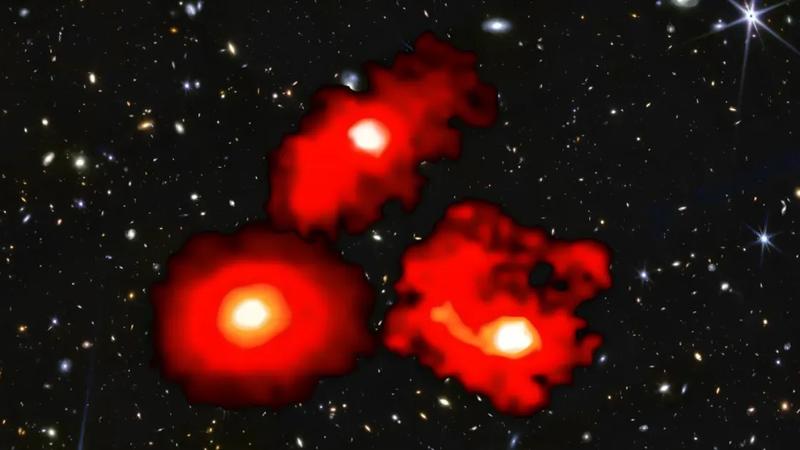Published 18:18 IST, November 22nd 2024
James Webb Space Telescope Discovers Mysterious 'Red Monsters' In Early Universe
James Webb Telescope discovers massive "Red Monsters" galaxies from early universe, challenging traditional galaxy formation models with rapid star growth.

James Webb Space Telescope, Red Monsters, galaxies, early universe, rapid star formation, cosmic dust, supermassive black holes, galaxy growth, redshift, JWST
The James Webb Space Telescope uncovers massive "Red Monsters" galaxies from the early universe, revealing rapid star formation and challenging existing galaxy formation models. These findings offer new insights into cosmic evolution and the universe's infancy.
A groundbreaking study using the James Webb Space Telescope (JWST) has revealed three enormous and enigmatic galaxies, nicknamed "Red Monsters," that existed just one billion years after the Big Bang. These galaxies, comparable in size to the Milky Way, defy long-standing models of galaxy formation and raise critical questions about how such massive structures could emerge so early in the universe's history.
Disrupting the Standard Model of Galaxy Formation
For decades, astronomers believed galaxy formation followed a relatively predictable pattern: gas and dust clumped together to form stars, and over billions of years, these clusters grew larger through mergers. However, observations from the JWST challenge this traditional model. Instead of finding small, immature galaxies in the early universe, researchers discovered massive, fully formed galaxies.
This surprising discovery suggests the need to rethink how galaxies grew during the universe’s infancy. “The extreme characteristics of these galaxies — high mass and rapid star formation — are inherent to the galaxies themselves,” the researchers concluded.
The 'Red Monsters' and Their Unusual Properties
The study, conducted by an international team led by the University of Geneva (UNIGE), focused on 36 massive, dusty, star-forming galaxies with redshift values between z = 5 and z = 9. These values correspond to the universe’s first 1–1.5 billion years. Among these galaxies, three stood out due to their extraordinary size, rapid star formation rates, and unique red color.
The "Red Monsters" appear red in JWST images because of their heavy dust content. Cosmic dust absorbs shorter wavelengths of light and scatters the remaining light into longer, reddish wavelengths. This is where JWST’s infrared capabilities shine; unlike the Hubble Space Telescope, which observes primarily optical light, JWST can see through cosmic dust to reveal these hidden galaxies.
These galaxies not only possess high stellar masses but also form stars at rates two to three times faster than later galaxies. Their growth requires a stellar-mass conversion efficiency of about 50%, far exceeding the typical 20% efficiency observed in most galaxies today.
Ruling Out Supermassive Black Holes
One initial hypothesis to explain the brightness and massiveness of these galaxies was the presence of active galactic nuclei (AGN). AGNs are powered by supermassive black holes that emit intense radiation as they consume matter, making galaxies appear brighter and more massive than they actually are.
However, the JWST data found no evidence of AGNs in the "Red Monsters." This discovery suggests that their size and brightness are intrinsic, resulting from their rapid star formation and large dust content, rather than external factors like AGNs.
Advanced Tools Behind the Discovery
The research team utilized data from JWST's FRESCO survey, which employs the telescope’s Near Infrared Camera (NIRCam) grism spectrograph. This instrument allows scientists to measure the distances and stellar masses of galaxies by analyzing how their light shifts due to the expanding universe.
“The instrument on board the space telescope allows us to identify and study the growth of galaxies over time, and to obtain a clearer picture of how stellar mass accumulates over the course of cosmic history,” said Pascal Oesch, associate professor at UNIGE and principal investigator of the observation program.
The team’s analysis revealed that while most of the studied galaxies conformed to theoretical models, the three "Red Monsters" were categorized as ultramassive. Their intense star formation rates and enormous dust content make them outliers, providing new challenges to existing cosmological theories.
A Mystery of Rapid Growth
One of the most puzzling aspects of the "Red Monsters" is how they grew so large, so quickly. Traditional galaxy formation models struggle to explain such rapid accumulation of mass and efficiency in star formation.
Researchers speculate that the early universe may have had conditions conducive to faster galaxy growth, such as an abundance of gas or more efficient cooling mechanisms. However, these hypotheses remain unproven, and further observations are needed to understand the underlying causes of this accelerated growth.
"Our research is transforming our understanding of early galaxy formation," said Mengyuan Xiao, the study’s lead author and a postdoctoral researcher at UNIGE.
Implications for Cosmology
The discovery of the "Red Monsters" has profound implications for cosmology. It suggests that the early universe may have experienced a more dynamic and efficient phase of galaxy formation than previously thought. These findings challenge the traditional "slow and steady" model of galaxy growth and open new avenues for exploring the universe’s infancy.
“As we study these galaxies in more depth, they will offer new insights into the conditions that shaped the universe’s earliest epochs,” Xiao concluded.
Looking Ahead
Future observations using JWST and the Atacama Large Millimeter Array (ALMA) will provide deeper insights into these ultramassive galaxies. By studying a larger sample of similar galaxies, scientists hope to uncover the mechanisms behind their rapid growth and determine whether these conditions were unique to the early universe.
The "Red Monsters" mark a turning point in our understanding of the cosmos. With JWST's unparalleled capabilities, astronomers are beginning to uncover the secrets of the universe's earliest moments, paving the way for transformative discoveries in the years to come.
Updated 18:18 IST, November 22nd 2024



